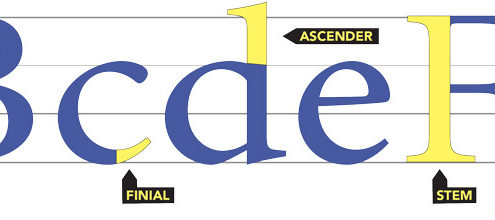A Character study
Putting a little typographical know-how into your journal or magazine can aid both editor and reader
By Pamela Grainger Tilson
In elementary school, I remember experiencing a strange fascination with the shapes and styles of letters. Some of my early memories (besides the layground, with its greased-lightning slide) involved playing with the small cardboard letters the teacher gave us. Spreading the letters out on top of my desk, I marveled at the variations. Some were tall and long, and others sat stoically on little black feet.
In that 1960s–era elementary classroom, cursive and block letters danced in a line atop the blackboard. Using sepia-toned Big Chief writing tablets and thick black pencils, we worked to contain those letters within solid and dashed lines. When we were old enough to practice writing our names, I remember thinking, “Where should I put the dot in the ‘i’? Should it go on the line above or could it go between the lines?” Then there was the letter “g,” that single character so full of possibilities. “Should the lower loop extend below the line or come to a hard, screeching halt on the line?”
True Texas
The Evolution of a brand
By Joan Henderson
Four years ago, we hired a creative director at Texas Highways to help us bring much-needed continuity to everything we do. As any regional publisher today, our monthly subscriber-based magazine is just one of the spokes on our wheel. We also produce a quarterly printed events calendar, a robust online presence, an email program — not to mention our various promotional brochures and maps. Although these were being produced by the same staff, each had its own look and feel. They were disparate elements lacking not just a consistent design but a unifying mission. What was the central goal we were trying to achieve in all of these efforts?
Facts From Fiction
Ten lessons from the world of fiction-writing that can help spark your magazine content
by Suzanne Johnson
It’s easy to think we’re different, those of us in the trenches of university magazines. After all, we have a captive audience. Our readers love their alma maters. They snatch our magazines from their mailboxes with a fervor usually reserved only for our athletics teams.
We kid ourselves, of course. We’re competing not only with junk mail, bills, and commercial magazines, but also the evening news, emails, social media, and — heaven forbid — actual humans.
Spring 2016 Departments
Vantage Point
In Magazine Publishing, Smaller Is Getting Bigger
Publishing in North America wasn’t always populated by mega-enterprises. In fact, the industry started as a collection of small entrepreneurial businesses, with larger publishers taking shape and achieving financial and visible prominence only after World War II. That is changing. After a 50-year pattern of ever-larger publishing ventures, the data now show a return to smaller enterprises. Armed with new technologies in a hyper-connected
marketplace, small publishers, and even sole practitioner publishers, are growing and thriving.
One of the indicators of this trend lies in magazine publishing employment. The U.S. Census Bureau’s County Business Patterns annual reports show that industry employment in 2000 was 170,500. By 2015, it fell to 98,500 — a level last seen in the late 1980s. Everyone in the industry has felt or witnessed the pain. Large publishers, primarily, closed their doors and shed significant numbers of workers. In 2000, there were 92 publishing companies with 250 or more employees; by 2014, there were 48.
The question is, where have these employees gone? Did they migrate to different industries? Or, perhaps, have they moved to different corners of the same industry, changing its fundamental structure?
When we dig further into the data, we see areas of growth — all of them consolidated in the arena of small publishing. We see an increase in the percentage of publishing companies with fewer than five employees. Since 2005, more than half of all periodical publishers (now 54 percent of them) have a staff this small. If we stretch the lens back further, we see that these publishers have more than doubled in number since 1986.
There is also growth among companies with just one employee, or “sole practitioners.” In 2000, there were 21,600 such businesses. By 2013, their ranks increased by 38 percent to 29,900 companies.


























